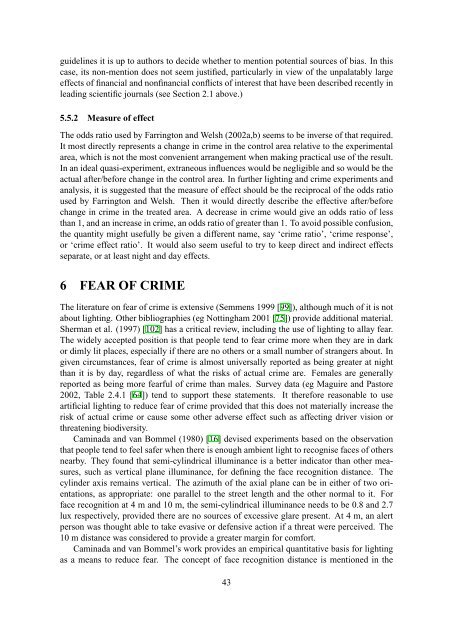outdoor lighting and crime, part 1 - Astronomical Society of Victoria
outdoor lighting and crime, part 1 - Astronomical Society of Victoria
outdoor lighting and crime, part 1 - Astronomical Society of Victoria
Create successful ePaper yourself
Turn your PDF publications into a flip-book with our unique Google optimized e-Paper software.
guidelines it is up to authors to decide whether to mention potential sources <strong>of</strong> bias. In this<br />
case, its non-mention does not seem justified, <strong>part</strong>icularly in view <strong>of</strong> the unpalatably large<br />
effects <strong>of</strong> financial <strong>and</strong> nonfinancial conflicts <strong>of</strong> interest that have been described recently in<br />
leading scientific journals (see Section 2.1 above.)<br />
5.5.2 Measure <strong>of</strong> effect<br />
The odds ratio used by Farrington <strong>and</strong> Welsh (2002a,b) seems to be inverse <strong>of</strong> that required.<br />
It most directly represents a change in <strong>crime</strong> in the control area relative to the experimental<br />
area, which is not the most convenient arrangement when making practical use <strong>of</strong> the result.<br />
In an ideal quasi-experiment, extraneous influences would be negligible <strong>and</strong> so would be the<br />
actual after/before change in the control area. In further <strong>lighting</strong> <strong>and</strong> <strong>crime</strong> experiments <strong>and</strong><br />
analysis, it is suggested that the measure <strong>of</strong> effect should be the reciprocal <strong>of</strong> the odds ratio<br />
used by Farrington <strong>and</strong> Welsh. Then it would directly describe the effective after/before<br />
change in <strong>crime</strong> in the treated area. A decrease in <strong>crime</strong> would give an odds ratio <strong>of</strong> less<br />
than 1, <strong>and</strong> an increase in <strong>crime</strong>, an odds ratio <strong>of</strong> greater than 1. To avoid possible confusion,<br />
the quantity might usefully be given a different name, say ‘<strong>crime</strong> ratio’, ‘<strong>crime</strong> response’,<br />
or ‘<strong>crime</strong> effect ratio’. It would also seem useful to try to keep direct <strong>and</strong> indirect effects<br />
separate, or at least night <strong>and</strong> day effects.<br />
6 FEAR OF CRIME<br />
The literature on fear <strong>of</strong> <strong>crime</strong> is extensive (Semmens 1999 [99]), although much <strong>of</strong> it is not<br />
about <strong>lighting</strong>. Other bibliographies (eg Nottingham 2001 [75]) provide additional material.<br />
Sherman et al. (1997) [102] has a critical review, including the use <strong>of</strong> <strong>lighting</strong> to allay fear.<br />
The widely accepted position is that people tend to fear <strong>crime</strong> more when they are in dark<br />
or dimly lit places, especially if there are no others or a small number <strong>of</strong> strangers about. In<br />
given circumstances, fear <strong>of</strong> <strong>crime</strong> is almost universally reported as being greater at night<br />
than it is by day, regardless <strong>of</strong> what the risks <strong>of</strong> actual <strong>crime</strong> are. Females are generally<br />
reported as being more fearful <strong>of</strong> <strong>crime</strong> than males. Survey data (eg Maguire <strong>and</strong> Pastore<br />
2002, Table 2.4.1 [64]) tend to support these statements. It therefore reasonable to use<br />
artificial <strong>lighting</strong> to reduce fear <strong>of</strong> <strong>crime</strong> provided that this does not materially increase the<br />
risk <strong>of</strong> actual <strong>crime</strong> or cause some other adverse effect such as affecting driver vision or<br />
threatening biodiversity.<br />
Caminada <strong>and</strong> van Bommel (1980) [16] devised experiments based on the observation<br />
that people tend to feel safer when there is enough ambient light to recognise faces <strong>of</strong> others<br />
nearby. They found that semi-cylindrical illuminance is a better indicator than other measures,<br />
such as vertical plane illuminance, for defining the face recognition distance. The<br />
cylinder axis remains vertical. The azimuth <strong>of</strong> the axial plane can be in either <strong>of</strong> two orientations,<br />
as appropriate: one parallel to the street length <strong>and</strong> the other normal to it. For<br />
face recognition at 4 m <strong>and</strong> 10 m, the semi-cylindrical illuminance needs to be 0.8 <strong>and</strong> 2.7<br />
lux respectively, provided there are no sources <strong>of</strong> excessive glare present. At 4 m, an alert<br />
person was thought able to take evasive or defensive action if a threat were perceived. The<br />
10 m distance was considered to provide a greater margin for comfort.<br />
Caminada <strong>and</strong> van Bommel’s work provides an empirical quantitative basis for <strong>lighting</strong><br />
as a means to reduce fear. The concept <strong>of</strong> face recognition distance is mentioned in the<br />
43
















